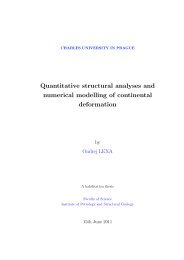PhD. thesis - Univerzita Karlova
PhD. thesis - Univerzita Karlova
PhD. thesis - Univerzita Karlova
Create successful ePaper yourself
Turn your PDF publications into a flip-book with our unique Google optimized e-Paper software.
and deformation of lithospheric structure described above. A numerical approach that enables<br />
us to model the deformation in a weak zone (Gemer Unit) surrounded by a rigid (Vepor Unit) or<br />
free boundaries is presented here. This approach is based on the thin viscous sheet<br />
approximation for modeling of the deformation. The Gemer Unit is assumed to be a horizontal<br />
weak tabular domain subjected to flow with no tractions at top and bottom surfaces. We also<br />
assume that vertical gradients of the horizontal velocity are negligible, which allows us to<br />
integrate the equations of motion over the vertical dimension and to work with vertical averages<br />
of stress and strain rate. The details are presented in appendix of Chapter 1. Using the<br />
assumption of Newtonian behaviour (linear relation between stress and strain rate), the<br />
procedure leads to a system of elliptic partial differential equations for two horizontal velocity<br />
components. The system is solved by the finite element method with boundary conditions,<br />
which represent the geological situation. In each time increment, boundaries are rearranged<br />
simultaneously with repeating solution of the governing equations for the velocity. At each time<br />
step we evaluate instantaneous strain rate and finite strain in a net of points in the domain. These<br />
numerical exercises significantly contribute to understanding of reasons of local changes in<br />
deformational regime due to deformation and help us to explain the origin of major structural<br />
features in studied area.<br />
During field studies in the West Carpathians we encountered a considerable problem<br />
related to Cretaceous extensional tectonics affecting the Vepor crystalline<br />
basement. The previous studies have resulted in the generally accepted model of post-orogenic<br />
or orogen-parallel extension. These studies are supported by geochronology, petrology, and<br />
particularly by interpretations of kinematic indicators namely, shear-bands. Our field revision<br />
points out that extensional tectonics was in fact the first Alpine deformation in the studied area<br />
and that it pre-dates the compressional stage of Alpine tectonic evolution. This causes that in<br />
many cases we deal with oblique sections across small-scale folds or crenulation cleavage,<br />
which are likely to be misinterpreted as shear-bands. In Chapter 2 we demonstrate that:<br />
1) distinguishing between compressional and extensional crenulation cleavages is not always<br />
an easy task, 2) unless this is fully appreciated there is a great danger of misinterpretation when<br />
the shear bands are used as kinematic indicators, 3) the compressional and extensional<br />
crenulation cleavages can appear identical when seen on flat outcrop surfaces or in thin<br />
sections. This work aims to alert that because the shear bands are such noticeable structures and<br />
their kinematic significance is straightforward, without detailed knowledge of 3D geometry of







